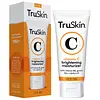What's inside
What's inside
 Key Ingredients
Key Ingredients

 Benefits
Benefits

 Concerns
Concerns

 Ingredients Side-by-side
Ingredients Side-by-side

Water
Skin ConditioningIsohexadecane
EmollientStearyl Heptanoate
EmollientGlycerin
HumectantButylene Glycol
HumectantIsopropyl Isostearate
EmollientNiacinamide
SmoothingCetearyl Olivate
Trehalose
HumectantSqualane
EmollientDimethicone
EmollientStearic Acid
CleansingAluminum Starch Octenylsuccinate
AbsorbentPolymethylsilsesquioxane
Silica
AbrasiveSodium Hyaluronate
HumectantPalmitoyl Tripeptide-1
Skin ConditioningPalmitoyl Tetrapeptide-7
Skin ConditioningPanthenol
Skin ConditioningSorbitan Olivate
EmulsifyingCetearyl Alcohol
EmollientGlyceryl Stearate
EmollientPEG-100 Stearate
Polyethylene
AbrasiveDisodium EDTA
Polyacrylate-13
Polyisobutene
Polysorbate 20
EmulsifyingCaprylyl Glycol
EmollientPhenoxyethanol
PreservativeEthylhexylglycerin
Skin ConditioningCarbomer
Emulsion StabilisingWater, Isohexadecane, Stearyl Heptanoate, Glycerin, Butylene Glycol, Isopropyl Isostearate, Niacinamide, Cetearyl Olivate, Trehalose, Squalane, Dimethicone, Stearic Acid, Aluminum Starch Octenylsuccinate, Polymethylsilsesquioxane, Silica, Sodium Hyaluronate, Palmitoyl Tripeptide-1, Palmitoyl Tetrapeptide-7, Panthenol, Sorbitan Olivate, Cetearyl Alcohol, Glyceryl Stearate, PEG-100 Stearate, Polyethylene, Disodium EDTA, Polyacrylate-13, Polyisobutene, Polysorbate 20, Caprylyl Glycol, Phenoxyethanol, Ethylhexylglycerin, Carbomer
Aloe Barbadensis Leaf
MaskingSunfloweramide Mea
CleansingIsopropyl Palmitate
EmollientGlyceryl Stearate
EmollientDimethyl Sulfone
SolventCetyl Alcohol
EmollientAscorbic Acid
AntioxidantStearic Acid
CleansingGlycerin
HumectantSimmondsia Chinensis Seed Oil
EmollientButyrospermum Parkii Butter
Skin ConditioningTocopherol
AntioxidantPantothenic Acid
Skin ConditioningCamellia Sinensis Leaf Extract
AntimicrobialEquisetum Arvense Extract
AstringentCentella Asiatica Extract
CleansingTaraxacum Officinale Extract
Skin ConditioningPelargonium Graveolens Oil
MaskingXanthan Gum
EmulsifyingPhenoxyethanol
PreservativeEthylhexylglycerin
Skin ConditioningAloe Barbadensis Leaf, Sunfloweramide Mea, Isopropyl Palmitate, Glyceryl Stearate, Dimethyl Sulfone, Cetyl Alcohol, Ascorbic Acid, Stearic Acid, Glycerin, Simmondsia Chinensis Seed Oil, Butyrospermum Parkii Butter, Tocopherol, Pantothenic Acid, Camellia Sinensis Leaf Extract, Equisetum Arvense Extract, Centella Asiatica Extract, Taraxacum Officinale Extract, Pelargonium Graveolens Oil, Xanthan Gum, Phenoxyethanol, Ethylhexylglycerin
 Reviews
Reviews

Ingredients Explained
These ingredients are found in both products.
Ingredients higher up in an ingredient list are typically present in a larger amount.
Ethylhexylglycerin (we can't pronounce this either) is commonly used as a preservative and skin softener. It is derived from glyceryl.
You might see Ethylhexylglycerin often paired with other preservatives such as phenoxyethanol. Ethylhexylglycerin has been found to increase the effectiveness of these other preservatives.
Glycerin is already naturally found in your skin. It helps moisturize and protect your skin.
A study from 2016 found glycerin to be more effective as a humectant than AHAs and hyaluronic acid.
As a humectant, it helps the skin stay hydrated by pulling moisture to your skin. The low molecular weight of glycerin allows it to pull moisture into the deeper layers of your skin.
Hydrated skin improves your skin barrier; Your skin barrier helps protect against irritants and bacteria.
Glycerin has also been found to have antimicrobial and antiviral properties. Due to these properties, glycerin is often used in wound and burn treatments.
In cosmetics, glycerin is usually derived from plants such as soybean or palm. However, it can also be sourced from animals, such as tallow or animal fat.
This ingredient is organic, colorless, odorless, and non-toxic.
Glycerin is the name for this ingredient in American English. British English uses Glycerol/Glycerine.
Learn more about GlycerinGlyceryl Stearate is a mix of glycerin and stearic acid.
It is used to stabilize the mixing of water and oil ingredients. By preventing these ingredients from separating, it can help elongate shelf life. It can also help thicken the product's texture.
As an emollient, it helps soften skin and supports barrier-replenishing ingredients.
In cosmetics, Glyceryl Stearate is often made from vegetable oils or synthetically produced.
This ingredient may not be fungal-acne safe
Fun fact: The human body also creates Glyceryl Stearate naturally.
Learn more about Glyceryl StearatePhenoxyethanol is a preservative that has germicide, antimicrobial, and aromatic properties. Studies show that phenoxyethanol can prevent microbial growth. By itself, it has a scent that is similar to that of a rose.
It's often used in formulations along with Caprylyl Glycol to preserve the shelf life of products.
Stearic Acid is a fatty acid. It is an emollient, emulsifier, and texture enhancer.
As an emollient, stearic acid helps soften skin. It aids the skin's protective barrier by preventing water loss. It also provides a gentle cleansing effect without stripping away natural oils.
Stearic acid may also be used to enhance the texture of products. It can add volume and stabilize ingredients such as water and oil. This can help water and oil ingredients from separating.
Sources of stearic acid include animal or vegetable fats/oils such as coconut or shea. It can be naturally found in butter, cocoa butter, shea butter, vegetable fats, and animal tallow.
This ingredient may not be Malassezia folliculitis, or fungal-acne safe.
Learn more about Stearic Acid